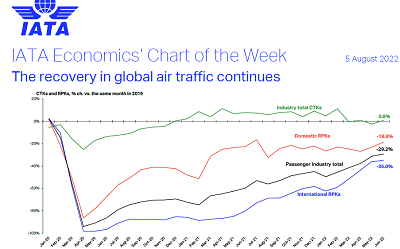
Airlines continue to demonstrate resilience and adaptability – IATA

The International Air Transport Association (IATA), the global representative body of the airline industry, recently reported that recovery in air travel remains strong even in June, showing healthy and stable performance, with the annual data showing a 76.2% increase compared to June 2021.
In its latest analysis of the global and regional passenger air travel market, IATA revealed that airlines continue to demonstrate resilience and adaptability in this challenging post-pandemic context in both passenger and cargo markets.
“Demand for air travel remains strong,” pointed out IATA Director General Willie Walsh. “After two years of lockdowns and border restrictions people are taking advantage of the freedom to travel wherever they can,” he added.
The air industry boss has also warned that flexibility is still essential in support of a successful recovery. “With the Northern Hemisphere summer travel season now fully underway, predictions that the lifting of travel restrictions would unleash a torrent of pent-up travel demand are being borne out. At the same time, meeting that demand has proved challenging and likely will continue to be so. All the more reason to continue to show flexibility to the slot use rules,” said Walsh.
“The global domestic market was significantly and repeatedly impacted in 2021, though strong demand ensured that traffic bounced back swiftly following each setback. Uncoordinated travel restrictions across regions caused international traffic to lag in the recovery. However, strong pent-up demand for foreign travel has accelerated the recovery in this area as and when restrictions on travel faded,”
Meanwhile, international traffic increased by 229.5% y-o-y, over June 2021, again due to fewer travel restrictions in most parts of the Asia-Pacific region. June 2022 international traffic reached 65% of June 2019 levels. In total, domestic traffic in June was at 81.4% of June 2019 levels,” IATA reported.
According to IATA data, domestic traffic for June 2022 was up 5.2% y-o-y compared to the same month a year ago. In addition, Asia-Pacific airlines had a 492.0% rise in June traffic compared to June 2021. “Capacity rose 138.9% and the load factor was up 45.8 percentage points to 76.7%.”
This comes after most markets reported strong improvements and China eased some of its COVID-19 Omicron variant lockdown restrictions. IATA represents some 290 airlines comprising 83% of global air traffic.
On the other hand, African airlines had a 103.6% rise in June revenue passenger kilometres (RPKs) versus a year ago. June 2022 capacity was up 61.9% and load factor climbed 15.2 percentage points to 74.2%, the lowest among regions. International traffic between Africa and neighboring regions is close to pre-pandemic levels, said IATA.
“European carriers’ June traffic rose 234.4% versus June 2021. Capacity rose 134.5%, and load factor climbed 25.8 percentage points to 86.3%. Middle Eastern airlines’ traffic rose 246.5% in June compared to June 2021. June capacity rose 102.4% versus the year-ago period, and load factor climbed 32.4 percentage points to 78.0%. North American carriers experienced a 168.9% traffic rise in June versus the 2021 period. Capacity rose 95.0%, and load factor climbed 24.1 percentage points to 87.7%, which was the highest in the region, and Latin American airlines’ June traffic rose 136.6% compared to the same month in 2021. June capacity rose 107.4% and load factor increased 10.3 percentage points to 83.3%.”
The total international market for June 2022 consists of all six regions, with North America 32.6%, Asia Pacific 27.5%, and Europe 25% having the largest shares. As per RPKs, Europe and Middle Eastern regions recorded the best results, 155.1%, and 216.8%, respectively, while Asia 33.7%, and North America 39.2% recorded the lowest results.
“By capping passenger numbers, airports are preventing airlines from benefitting from the strong demand. Heathrow Airport has tried to blame airlines for the disruption. However, Service Level Performance data for the first six months of this year show that they have failed miserably to provide basic services and missed their Passenger Security service target by a massive 14.3 points. Data for June has not yet been published but is expected to show the lowest level of service by the airport since records began,” said Walsh.












































